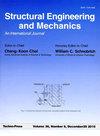Response surface-based model updating to detect damage on reduced-scale masonry arch bridge
IF 3
4区 工程技术
Q2 ENGINEERING, CIVIL
引用次数: 3
Abstract
Response surface (RS) methods, a combination of mathematical and statistical techniques, have been widely used in design optimization, response prediction, and model validation in structural engineering systems. However, its usage in structural damage identification, especially for historic structures has not been quite common. For this purpose, this study attempts to investigate damage detection in a masonry arch bridge. Within the scope of this, a reduced-scale model of a one span historical masonry arch bridge was built in a laboratory environment. To determine the modal parameters of the reduced-scaled bridge model, operational modal analysis (OMA) was performed under ambient vibrations. Signals originated by sensitive accelerometers were collected to quantify the vibratory response of the reduced-scaled model bridge. The experimental natural frequencies, mode shapes, and damping ratios resulting from these measurements were figured out by using the Enhanced Frequency Domain Decomposition (EFDD) technique. The three-dimensional model of the reduced-scale bridge was created in the ANSYS finite element (FE) software program to expose the analytical dynamic characteristics of the bridge model. The results obtained in the experimental application were compared with those of the finite-element analysis of the bridge model. The calibration of the numeric model was utilized depending on the experimental modal analysis results of the reduced-scale bridge by using the RS method. Design of experiments was constructed by using central composite design, and the RS models were generated by performing the genetic aggregation approach. The optimum results between the experimental and numerical analyses were found by using the RS optimization. Then, regional damages created on the scaled model and the changes of dynamic properties of the damaged case were evaluated. The damage location was approximately identified by using the RS method in the calibrated finite-element model. The results demonstrated that the RS-based FE updating approach is an effective way for damage detection and localization in masonry type structures.基于响应面模型更新的砌体小比例尺拱桥损伤检测
响应面方法是一种数学与统计相结合的方法,已广泛应用于结构工程系统的设计优化、响应预测和模型验证等方面。然而,它在结构损伤识别,特别是历史建筑损伤识别中的应用并不普遍。为此,本研究试图对砖石拱桥的损伤检测进行研究。在此范围内,在实验室环境下建立了一座单跨历史砌体拱桥的缩小模型。为了确定桥梁模型的模态参数,进行了环境振动下的运行模态分析(OMA)。通过采集敏感加速度计产生的信号,量化了模型桥梁的振动响应。利用增强频域分解(Enhanced Frequency Domain Decomposition, EFDD)技术计算得到实验固有频率、模态振型和阻尼比。在ANSYS有限元软件中建立缩比桥梁的三维模型,揭示桥梁模型的解析动力特性。将试验应用结果与桥梁模型有限元分析结果进行了比较。利用RS法对该桥梁进行了减尺试验模态分析,对数值模型进行了标定。采用中心组合设计构建试验设计,采用遗传聚集法生成RS模型。利用RS优化方法,在实验和数值分析中找到了最优的结果。在此基础上,对模型所产生的区域损伤和损伤体动力特性的变化进行了评价。在标定后的有限元模型中,采用RS法对损伤位置进行了近似识别。结果表明,基于rs的有限元更新方法是砌体结构损伤检测与定位的有效方法。
本文章由计算机程序翻译,如有差异,请以英文原文为准。
求助全文
约1分钟内获得全文
求助全文
来源期刊

Structural Engineering and Mechanics
工程技术-工程:机械
CiteScore
3.80
自引率
18.20%
发文量
0
审稿时长
11 months
期刊介绍:
The STRUCTURAL ENGINEERING AND MECHANICS, An International Journal, aims at: providing a major publication channel for structural engineering, wider distribution at more affordable subscription rates; faster reviewing and publication for manuscripts submitted; and a broad scope for wider participation.
The main subject of the Journal is structural engineering concerned with aspects of mechanics. Areas covered by the Journal include:
- Structural Mechanics
- Design of Civil, Building and Mechanical Structures
- Structural Optimization and Controls
- Structural Safety and Reliability
- New Structural Materials and Applications
- Effects of Wind, Earthquake and Wave Loadings on Structures
- Fluid-Structure and Soil-Structure Interactions
- AI Application and Expert Systems in Structural Engineering. Submission of papers from practicing engineers is particularly encouraged.
 求助内容:
求助内容: 应助结果提醒方式:
应助结果提醒方式:


